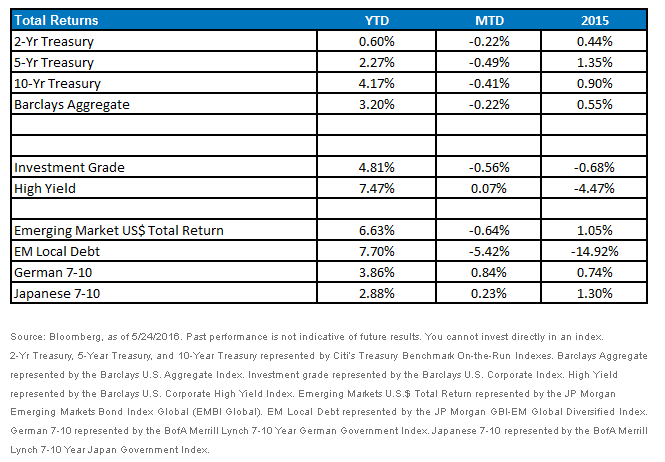Global Fixed Income: Let’s Go to the Videotape


 For definitions of Indexes in the chart, visit our glossary.
Within the investment-grade (IG) corporate market, a similar pattern has emerged. According to the Barclays U.S. Aggregate Corporate Total Return Value Unhedged Index, the IG sector was producing a positive performance of +4.81% heading into the Memorial Day weekend, a rather noticeable improvement from the +0.74% reading in early February. From the interest-sensitive side, U.S. Treasury market (UST) performance numbers improved more and more, the further out on the yield curve one goes. To illustrate, the UST 2-Year return came in at a rather modest +0.60%, as compared to a more solid showing of +4.17% for the UST 10-Year (utilizing the Citi 2-Year and 10-Year Treasury Benchmark On-the-Run Index).
Conclusion
Future central bank policy decisions could certainly play an important role for how “the videotape” looks when the calendar reaches the autumnal equinox and beyond. In fact, investors may have already begun to witness some markets pricing in the Fed potentially raising rates at either its June or July policy meetings. The EM local debt space has witnessed a pronounced shortfall, falling -5.42% on a month-to-date basis as of May 24. This decline is mostly a reflection of a stronger dollar, as the EM U.S. dollar (USD) market lost a far smaller -0.64% (JPMorgan Emerging Market Bond Index – Global). It seems to be no coincidence that the recent USD rebound coincided with the recent FOMC minutes and additional Fed rhetoric, which placed a possible June rate hike back on the table.
For definitions of Indexes in the chart, visit our glossary.
Within the investment-grade (IG) corporate market, a similar pattern has emerged. According to the Barclays U.S. Aggregate Corporate Total Return Value Unhedged Index, the IG sector was producing a positive performance of +4.81% heading into the Memorial Day weekend, a rather noticeable improvement from the +0.74% reading in early February. From the interest-sensitive side, U.S. Treasury market (UST) performance numbers improved more and more, the further out on the yield curve one goes. To illustrate, the UST 2-Year return came in at a rather modest +0.60%, as compared to a more solid showing of +4.17% for the UST 10-Year (utilizing the Citi 2-Year and 10-Year Treasury Benchmark On-the-Run Index).
Conclusion
Future central bank policy decisions could certainly play an important role for how “the videotape” looks when the calendar reaches the autumnal equinox and beyond. In fact, investors may have already begun to witness some markets pricing in the Fed potentially raising rates at either its June or July policy meetings. The EM local debt space has witnessed a pronounced shortfall, falling -5.42% on a month-to-date basis as of May 24. This decline is mostly a reflection of a stronger dollar, as the EM U.S. dollar (USD) market lost a far smaller -0.64% (JPMorgan Emerging Market Bond Index – Global). It seems to be no coincidence that the recent USD rebound coincided with the recent FOMC minutes and additional Fed rhetoric, which placed a possible June rate hike back on the table.
Important Risks Related to this Article
Fixed income investments are subject to interest rate risk; their value will normally decline as interest rates rise. In addition, when interest rates fall, income may decline. Fixed income investments are also subject to credit risk, the risk that the issuer of a bond will fail to pay interest and principal in a timely manner or that negative perceptions of the issuer’s ability to make such payments will cause the price of that bond to decline.


